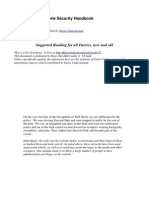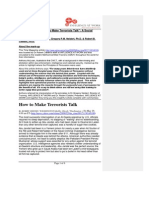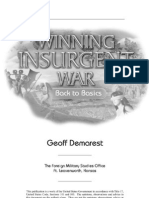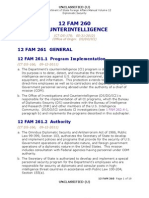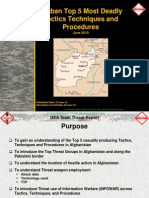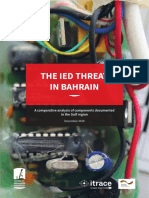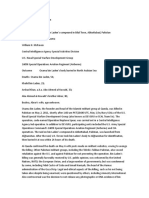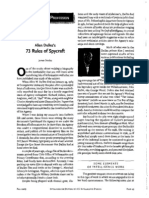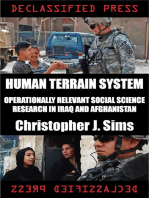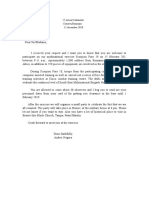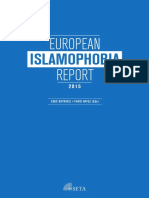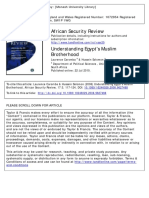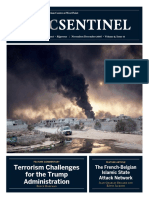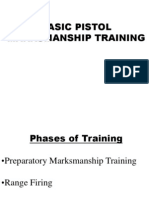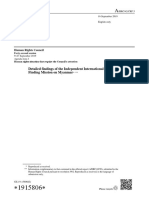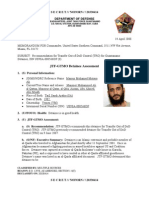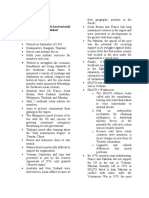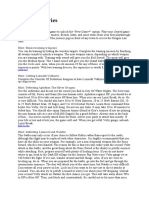EUROPOL Exploring The Role of Instructional Material in AQAPs Inspire and ISIS Rumiyah
EUROPOL Exploring The Role of Instructional Material in AQAPs Inspire and ISIS Rumiyah
Uploaded by
Adriana StanescuCopyright:
Available Formats
EUROPOL Exploring The Role of Instructional Material in AQAPs Inspire and ISIS Rumiyah
EUROPOL Exploring The Role of Instructional Material in AQAPs Inspire and ISIS Rumiyah
Uploaded by
Adriana StanescuOriginal Description:
Original Title
Copyright
Available Formats
Share this document
Did you find this document useful?
Is this content inappropriate?
Copyright:
Available Formats
EUROPOL Exploring The Role of Instructional Material in AQAPs Inspire and ISIS Rumiyah
EUROPOL Exploring The Role of Instructional Material in AQAPs Inspire and ISIS Rumiyah
Uploaded by
Adriana StanescuCopyright:
Available Formats
The Hague, 26/05/2017
Exploring the Role of Instructional Mate-
rial in AQAP’s Inspire and ISIS’ Rumiyah
This paper was presented at the 1st European Counter Terrorism Centre (ECTC) conference on
online terrorist propaganda, 10-11 April 2017, at Europol Headquarters, The Hague.
The views expressed are the authors’ own and do not necessarily represent those of Europol.
Authors: Dr. Alastair Reed & Dr. Haroro J. In-
gram
Europol Public Information
1 Introduction
In recent years Europe has faced an increasing wave of so-called ‘lone actor’ attacks
committed by jihadist (or jihadist-inspired) terrorists. This trend has continued in
2017. For example, the attacks in London and Stockholm, which were simple but
devastating in their methodology. Both attacks used vehicles to run pedestrians
down. While the London attacker disembarked to engage in a deadly knife attack,
an unexploded bomb was subsequently found in the truck used in the Stockholm at-
tack1. As has been noted by commentators, all of these methods have been de-
scribed in detail in recent ‘how-to-guide’ articles in English language jihadist maga-
zines, such as in the ‘Open Source Jihad’ (OSJ) section of Al-Qaeda in the Arabian
Peninsula’s (AQAP) Inspire magazine and the ‘Just Terror’ (JT) section of ISIS’ Rumi-
yah magazine. These trends have re-opened the debate about the role and impact of
such ‘how-to’ guides in provoking violence by providing would-be terrorists with
the practical knowledge to carry out such attacks. Drawing on content analyses of
Inspire and Rumiyah magazines, we argue that groups like ISIS and AQAP under-
stand that their instructional material is of little value unless they can convince
supporters to adopt their ‘competitive system of meaning’ (i.e. their way of perceiv-
ing the world, its actors and events). Thus it would be wrong to focus myopically on
‘how-to’ operational guides when trying to understand and counter violent extrem-
ist propaganda. This paper begins by exploring the history of instructional material
in terrorist propaganda before going on to examine the role of Inspire’s OSJ section
and Rumiyah’s JT section within the broader context of the groups’ messaging ef-
forts. It concludes by outlining CT-CVE strategic communications recommendations
for both proactively undermining this type of violent extremist messaging and re-
sponding post-incident to directed versus inspired attacks.
1
E. Allen & B. Henderson: Westminster attack: Everything we know so far about the events in London. In: The
Telegraph http://www.telegraph.co.uk/news/2017/03/22/westminster-terror-attack-everything-know-far/ (26
March 2017); L. Dearden: Stockholm attack: 'Homemade bomb' found in lorry used to kill at least four people
in Sweden Suspect arrested on suspicion of murder and terror offences. In: The Independent
http://www.independent.co.uk/news/world/europe/stockholm-attack-sweden-lorry-truck-crash-terror-isis-
islamic-state-manhunt-latest-suspect-police-a7673527.html (8 April 2017)
EUROPOL PUBLIC INFORMATION 2 / 17
2 Historical Overview of Instructional Material
The history of modern instructional material can be traced back to at least the late-
1800s and bomb-making manuals produced by anarchist groups, a trend that con-
tinued to grow in the 1900s, with examples such as the Mini-Manual of the Urban
Guerrilla, the Anarchist Cookbook and The Turner Diaries.2 Meanwhile, groups like
the original Irish volunteers were including ‘how-to guide’ sections in their maga-
zine, ‘An T'Oglach’, as early as the 1920s.3 In short, the ‘how-to guide’ sections in ji-
hadist magazines are not particularly unique. Indeed, as is so often the case, these
materials should be seen as merely strategic plagiarising of best practice.
History provides extensive examples of terror attacks that were carried out using
modi operandi gained from ‘how-to guides’. From the Haymarket Square bombing
in 1886,4 in which The Science of Revolutionary Warfare is alleged to have provided
instruction for the bombers to The Turner Diaries which, since its publication in
1978, has inspired attacks resulting in over two hundred deaths, including the 1995
Oklahoma City bombing by Timothy McVeigh – the single deadliest act of domestic
terrorism in U.S. history.5 What is important about The Turner Diaries, and this gives
the key to understanding the role of OSJ and JT, is that the instructional mate-rial is
embedded within a narrative designed to justify and inspire such attacks, in-cluding
ideological justifications and frantic calls to action. McVeigh did not just draw out
operational guidance from reading The Turner Diaries, his world view was shaped
by the ‘competitive system of meaning’ espoused within its narratives. Simi-larly,
the key to understanding how magazines like Inspire and Rumiyah may moti-vate
supporters to engage in terrorism is to understand how OSJ and JT within the same
broader context.
2 A. Larabee: A Brief History of Terrorism in the United States. In: Knowledge, Technology & Policy
16, p.21 (2003)
3 The Official Organ of the Irish Volunteers. In: T'Oglach Magazine
3(31), p.3 http://www.militaryarchives.ie/collections/online-collections/an-
toglach-magazine/results?title=&subtitle=&text=&pubdate=1921 (21
October 1921)
4 K. Anderson: The History of Do-It-Yourself Weapons and Explosives Manuals in America. In:
Lawfare https://www.lawfareblog.com/history-do-it-yourself-weapons-and-explosives-manuals-america
(21 June 2016)
5 J.M Berger, “The Turner Legacy: The Storied Origins and Enduring Impact of White Nationalism’s
Deadly Bi-ble”, The International Centre for Counter-Terrorism – The Hague 7, no. 8 (2016) https://icct.nl/wp-
content/uploads/2016/09/ICCT-Berger-The-Turner-Legacy-September2016-2.pdf .
EUROPOL PUBLIC INFORMATION 3 / 17
3 Decline of Training Camps and the Move to Individual Ji-
had
In his analysis of how Europe’s jihadis gained their training, Peter Nesser noticed
that there were two distinct generations. The first “generation networks that were
closely associated with Al Qaeda and received terrorist training in Al Qaeda run
camps in Afghanistan”6, which carried out attacks in Europe from 1998 until
2003/4, a couple of years after the destruction of the training camps. The second
“generation networks that have weaker or more indirect ties to Al Qaeda and pre-
sumably have found alternative ways to obtain training after Al Qaeda camps were
destroyed”, emerging as a European threat from 2003/4 onwards.7 In contrast to
the first, the second “generation activists, the “home grown” terrorists, operated
quite autonomously” from the militant groups that inspired them, 8 seemingly high-
lighting a transition to a new terrorist wave, that Sageman would describe as “con-
sists mostly of would-be terrorists, who, angered by the invasion of Iraq, aspire to
join the movement and the men they hail as heroes. But it is nearly impossible for
them to link up with al Qaeda Central, which was forced underground after 9/11.
Instead, they form fluid, informal networks that are self-financed and self-trained.
They have no physical headquarters or sanctuary, but the tolerant, virtual envi-
ronment of the Internet offers them a semblance of unity and purpose. Theirs is a
scattered, decentralized social structure-a leaderless jihad”. 9
The notion of leaderless or individual jihad is not new, and can be found in the writ-
ings and lectures of influential jihadi strategist Abu Mus’ab al-Suri back in the 1990s. In
his strategic concept that became known as “The Global Islamic Re-sistance”, al-Suri
highlighted lone wolf attacks carried out by individuals with no di-rect connection to
AQ, but which where nevertheless carried out in support of AQ global Ideology 10. In
2003, following Al-Qaeda’s routing from Afghanistan it sought to re-calibrate its
military strategy, adopting an approach aimed at exhausting the
6 P. Nesser: How did Europe's Global Jihadis Obtain Training for their Militant Causes? In: Terrorism and
Politi-cal Violence 20(2) http://www.tandfonline.com/doi/abs/10.1080/09546550801920758 (2008)
7 Ibid, 235
8 Ibid, 241
9 M. Sageman: The Next Generation of Terror. In: Foreign Policy
http://foreignpolicy.com/2009/10/08/the-next-generation-of-terror/ (8 October 2009)
10 A. Stenersen: Bomb-Making for Beginners: Inside al an Al-Qaeda E-Learning Course. In: Perspectives on
Ter-rorism 7(1) http://www.terrorismanalysts.com/pt/index.php/pot/article/view/241/html (2013)
EUROPOL PUBLIC INFORMATION 4 / 17
enemy by attacking his interests world wide11. This new strategy would in turn
have a direct impact on how Al-Qaeda trained its operatives. As Kohlmann articu-
lates “Given its weakened position, al Qaeda no longer had the luxury of importing
large numbers of unskilled operatives into Afghanistan solely for the purpose of
training, only to then immediately export them elsewhere. With a renewed empha-
sis on self-financed, self-trained, and self-motivated terrorist cells, Bin Laden’s
aides began ardently working to spread their collective knowledge and practical
skills over the Internet”.12
This change of strategic direction, would require a new approach to training re-
cruits to replace training camps, both for practical and ideological instruction. The
real challenge with the move to individual jihad, would be how to inspire and moti-
vate individuals into action without direct contact. The internet would soon fill this
void with jihadist propaganda designed to inspire individual jihad. Soon English
language magazines such as AQ’s Inspire, and ISIS’ Dabiq and then Rumiyah would
emerge. The objective of the former has been described as “Inspire is characterized
by a streamlined and seamless fusion of ideologically driven material with prag-
matic instructional and skill-building content. Taken together, these elements are
intended simultaneously to increase motivation and lower the barriers of entry to
terrorism, with the aim of fostering a do-it-yourself ethos resulting in terrorist be-
haviors”. 13 In the section below we give an overview of the instructional material in
OSJ and JT.
11 E.F. Kohlmann: “Homegrown” Terrorists: Theory and Cases in the War on Terror's Newest Front: In: The
An-nals of the American Academy of Political and Social Science 618(1), p. 98
http://journals.sagepub.com/doi/abs/10.1177/0002716208317203 (2008)
12 Ibid.
13 A.F. Lemieux, et al.: Inspire Magazine: A Critical Analysis of its Significance and Potential Impact Through
the Lens of the Information. In: Terrorism and Political Violence 26(2), p.355
http://www.tandfonline.com/doi/abs/10.1080/09546553.2013.828604 (2014)
EUROPOL PUBLIC INFORMATION 5 / 17
4 Inspire – ‘Open Source Jihad’
Inspire magazine was first published by Al-Qaeda in the Arabian Peninsula (AQAP)
in January 2010, the brainchild of Americans, Anwar al-Awlaki and Samir Khan. The
magazine was notable for its engaging format, its focus on inspiring followers to
engage in ‘individual jihad’ against the west, and its ‘how-to-guide’ section ‘Open
Source Jihad’. OSJ covered a wide variety of technical advice (see Table 1) from
training in the use of encryption to using firearms and building home-made bombs.
What is particularly interesting about Inspire’s OSJ section is the variety of instruc-
tional advice it provides supporters, from methods requiring relatively high levels
of sophistication, such as improvised explosive devices, to vehicular and arson at-
tacks. The technical advice gained from OSJ has been cited by law enforcement in
many successful and foiled terrorist attacks, most notably the 2013 Boston Bomb-
ing in which the pressure cooker bomb used was based on OSJ instructions. 14 Re-
flecting the tendency for Western jihadists to be undiscerning in the propaganda
they consume, OSJ guides have apparently influenced ‘homegrown terrorists’
whose attacks were preceded by a pledge of allegiance to AQ’s rival, ISIS (e.g. San
Bernadino shooters).15
14 H.A. Sarat-St. Peter: “Make a Bomb in the Kitchen of Your Mom”: Jihadist Tactical Technical
Communication and the Everyday Practice of Cooking. In: Technical Communication Quarterly 26(1), p.77
http://www.tandfonline.com/doi/abs/10.1080/10572252.2016.1275862?journalCode=htcq20 (2017); A.F. Lemieux,
et al.: Inspire Magazine: A Critical Analysis of its Significance and Potential Impact Through the Lens of the
Information, p.355 http://www.tandfonline.com/doi/abs/10.1080/09546553.2013.828604 (2014)
15 H.A. Sarat-St. Peter: “Make a Bomb in the Kitchen of Your Mom”: Jihadist Tactical Technical
Communication and the Everyday Practice of Cooking. In: Technical Communication Quarterly 26(1), p.77
http://www.tandfonline.com/doi/abs/10.1080/10572252.2016.1275862?journalCode=htcq20 (2017)
EUROPOL PUBLIC INFORMATION 6 / 17
Table 1: Inspire’s ‘Open Source Jihad’ Section
Inspire Open Source Jihad (Instructional Material)
Magazine
Issue 1 “Make a bomb in the kitchen of your mom”, The AQ Chef
“How to use Asrar al-Mujahideen: Sending & Receiving Encrypted Messages”,
Terr0r1st
Issue 2 “The ultimate mowing machine”, Yahya Ibrahim
“Asrar Al-Mujahideen 2.0 extras”, Terr0r1st
Issue 3 (Special Issue)
Issue 4 “Destroying Buildings”, AQ Chef
“Training with the AK”, Abu Salih
“Advice for those who want to help Al-Malahem Media”, Terr0r1st
Issue 5 “Training with the AK 2”, Abu Salih
Issue 6 “Training with the AK”, Abu Saleh
“Making acetone peroxide”, Dr Khateer
Issue 7 (Special Issue)
Issue 8 “Training with the handgun”, Abu Saleh
“Remote control detonation”, Dr. Khateer
Issue 9 “The convoy of martyrs: Rise up and board with us”
“It is your freedom to ignite a firebomb”, The AQ Chef
“Qualities of an urban assassin”, Uthman Ibn Al-Ightiyal
Issue 10 “Torching parked vehicles”, Ibnul Irhab
“Causing road accidents”, AQ Chef
“You ask, we answer”, AQ Consultant
Issue 11 (Special Issue)
Issue 12 “Car bombs inside America”, AQ Chef
“Car bomb: Field data”, AQ Chef
Issue 13 “The hidden bomb”
“Breaching security barriers”, The AQ Chef
“Making the hidden bomb”, The AQ Chef
“Field Tactics” External Operations Reconnaissance Team
Issue 14 “Assassination Operations”
“Designing a timed hand grenade”, The AQ Chef
“Assassinations Field Tactics” Reconnaissance Team
Issue 15 “Professional Assassinations”, Prepared by the External Operations Team
“Home Assassinations: Parcel Bomb, Magnet Car Bomb, Door-Trap Bomb”, The AQ
Chef
Inspire 16 (Special Issue)
5 Rumiyah – ‘Just Terror’
First published in September 2016, Islamic State’s Rumiyah magazine, translated as
‘Rome’, is a reference to the Hadith in which the Prophet Mohamed declared that
the Muslim armies would conquer Constantinople and then Rome. Unlike its prede-
cessor magazine Dabiq, Rumiyah’s ‘Just Terror Tactics’ section offers its readers in-
EUROPOL PUBLIC INFORMATION 7 / 17
structional guidance for engaging in terrorist attacks. Detailed in Table 2, Rumiyah’s
JT section is not unique in the operational advice that it provides readers with,
similar content featuring in Inspire (not to mention often years earlier too). JT has
tended to focus on simpler, less sophisticated types of attacks whereas Inspire
tended to offer a mix. While drawing causal links between JT and recent attacks is
problematic, analysts have noted the similarity in JT’s operational advice and the
Berlin Christmas market, Westminster and Stockholm attacks. 16
Table 2: Rumiyah’s ‘Just Terror Tactics’ Section
Rumiyah Just Terror Tactics (Instructional Material)
Magazine
Issue 1 -
Issue 2 Knife Attacks
Issue 3 Vehicle Attacks
Issue 4 Knife Attacks
Issue 5 Arson Attacks
Issue 6 -
Issue 7 -
Issue 8 -
Issue 9 Hostage Taking
6 Role of Instructional Material
It is interesting to first examine what the groups themselves say about the West’s
reaction to these ‘how-to-guide’ sections. Inspire’s chief editor openly mocks the
West’s fixation on the sections, writing that “[t]he kuffar [disbelievers] are so terri-fied
by this section. In fact, they limit the weight of the magazine on this section alone,
while they forget that all a Muslim needs to fight the kuffar is enough Iman [faith] and
the simplest of tools. Thus, the magazines [sic] content complete each
16 C. Mortimer: Berlin attack: Isis magazine offered tips on carrying out Nice-style lorry assault Rumiyah
offered tips and tricks to maximise the number of casualties. In: The Independent
http://www.independent.co.uk/news/world/europe/stockholm-attack-sweden-lorry-truck-crash-terror-isis- islamic-
state-manhunt-latest-suspect-police-a7673527.html (8 April 2017); U. Friedman: The Terrifying Simplic-ity of the
Stockholm Attack “Very few actually comprehend the deadly and destructive capability of the motor vehicle,” an ISIS
publication advises. In: The Atlantic https://www.theatlantic.com/international/archive/2017/04/stockholm-truck-
attack/511364/ (7 April 2017)
EUROPOL PUBLIC INFORMATION 8 / 17
other”.17 The point is that, at least from the perspective of Inspire’s architects, the
knowledge contained in OSJ is not most important for carrying out an attack, rather
it is a shared understanding of the world as presented by AQAP. After all, Inspire,
like Rumiyah, is dominated by content that is designed to shape the perceptions and
polarise the support of its readership via a range of appeals wrapped in powerful
narratives while operational content in either magazine takes up a handful of the
40-50 pages that make up an issue. It follows that if instructional material was
deemed most important for radicalising and operationalising supporters, this
would be reflected in a much greater proportion of the magazine being devoted to
such content. To motivate an individual to follow the advice contained in either
AQAP’s or ISIS’ ‘how-to-guide’ requires an individual to perceive their actions as not
just justified, but an urgent necessity within at least a wider politico-military
strategy if not a cosmic struggle.
7 Competitive Systems of Meaning
A key purpose of violent extremist propaganda is to provide supporters with a
‘competitive system of meaning’, i.e. through which it seeks to shape its reader-
ship’s perceptions, polarise their support and radicalise them towards legitimising
and engaging in terrorism.18 While space considerations will not allow an in-depth
analysis here, groups like ISIS and AQAP variously interplay in-group identity, Oth-
er, crisis and solution constructs into cyclically self-reinforcing narratives. 19 As
graphically represented in Figure 1, both ISIS and AQAP present themselves as
champions of the in-group identity (Sunni Muslims) and everyone else as out-group
identities (Others) as enemies responsible for crises that only they (i.e. AQAP or
ISIS) are able to solve. Consequently, the more that perceptions of crisis can be in-
creased and attached to Others the greater the sense of urgency for the in-group to
implement solutions (and vice versa). As perceptions of crisis become increasingly
acute, it follows that solutions need to be more and more extreme.
17 Y. Ibrahim: Inspired by 'Inspire’. In: Inspire Magazine 11
https://azelin.files.wordpress.com/2013/05/inspire- magazine-issue-11.pdf p.19 (2013)
18 H.J. Ingram: An Analysis of Inspire and Dabiq: Lessons from AQAP and Islamic State's Propaganda War. In:
Studies in Conflict & Terrorism (40)5 http://www.tandfonline.com/doi/full/10.1080/1057610X.2016.1212551
(2017)
19 H.J. Ingram (2016) ‘Deciphering the Siren Call of Militant Islamist Propaganda: Meaning, Credibility &
Behav-ioural Change’. The International Centre for Counter-Terrorism – The Hague 7, no. 9 https://icct.nl/wp-
content/uploads/2016/09/ICCT-Ingram-Deciphering-the-Siren-Call-of-Militant-Islamist-Propaganda-
September2016.pdf.
EUROPOL PUBLIC INFORMATION 9 / 17
Figure 1: System of Meaning
Groups like ISIS and AQAP understand that the deeper supporters can be coaxed in-to
this psychological web and adopt this as their lens through which to understand the
world, the easier it becomes to convince them to engage in acts of violence.
Take issue 9 of Rumiyah as an example. The issue opens with its feature article ti-
tled ‘The ruling on the belligerent Christians’ stating:20
At a time when Muslims are being killed in the east and in the west –
men, women, children, and the elderly altogether – and when the mush-
rikin and murtaddin are deploying all manner of destructive weaponry
against them, raining devastation on their villages and towns, the evil
scholars, the preachers of misguidance, and the tawaghit of the demo-
cratic parties are busy weeping over every mushrik struck by the hands
of the mujahidin and disavowing themselves of every attack carried out
against their Crusader allies, claiming that Islam does not permit such
deeds and accusing those who carry them out of tarnishing the reli-
gion’s image. Their sinful tongues and filthy pens even go so far as to
give those harbi (belligerent) kuffar protection with respect to their
blood and their wealth, and to defame the noble muwahhidin, who car-
20 The ruling on the belligerent Christians. In: Rumiyah 9, pp.5-10 (2017)
EUROPOL PUBLIC INFORMATION 10 / 17
ried out Allah’s judgment on the mushrikin and, through their blessed
deeds – not just their words – revived shar’i rulings which the tawaghit
and their allies endeavored to either wipe out or replace. From among
these blessed deeds were the successive attacks which the soldiers of
the Islamic State in Misr and Sinai carried out against the Christians in
those lands, targeting them with killings and assassinations, and afflict-
ing their churches with burning and explosions.21
It should be clear from this quote how ISIS seeks to increase perceptions of crisis in
their audience, attaching responsibility for that malaise to not only those outside of
the in-group identity but traitors within it, to justify and legitimise violence. Ex-
treme crisis requires extreme solutions. This is what follows before the ‘Just Terror
Tactics’ section:
- A one page infographic identifying five reasons why ‘Jews and Christians’
are enemies then appears,22
- A rehashed article by ISIS’ deceased founder Abu Musab al-Zarqawi titled
‘And likewise the Messengers are afflicted, then the final outcome is theirs
(Part 2)’,23
- Another infographic titled ‘Seven shaded by Allah in his shade’,24
- An article for women ‘The woman is a shepherd in her husband’s home and
responsible for her flock’,25
- An article by Shaykh Sulayman Ibn ‘Abdillah Ibn Muhammad Ibn ‘Abdil-
Wahab titled ‘They took their scribes and monks as lords besides Allah’, 26
- An ‘exclusive’ content article ‘Be patient, for indeed the promise of Allah is
true’ by ‘The Mujahid Shaykh Abul-Hasan Al-Muhajir’,27
21 Ibid, p.5
22 Ibid, p.11
23 Abu Musab Al-Zarqawi: And likewise the Messengers are afflicted, then the final outcome is theirs (Part
2). In: Rumiyah 9, pp.12-16 (2017)
24 Seven shaded by Allah in his shade. In: Rumiyah 9, p. 17 (2017)
25 The woman is a shepherd in her husband’s home and responsible for her flock. In: Rumiyah 9, p. 18-
21 (2017)
26 Shaykh Sulayman Ibn: Abdillah Ibn Muhammad Ibn Abdil-Wahab, They took their scribes and monks as
lords besides Allah. In: Rumiyah 9, pp.22-25 (2017)
27 Abul-Hasan Al-Muhajir: Be patient, for indeed the promise of Allah is true. In: Rumiyah 9, pp.26-35 (2017)
EUROPOL PUBLIC INFORMATION 11 / 17
- The third article in ‘The establishment of the Islamic State’ series titled ‘The
Twelver Rafidah from a fabricated claim to a non-existent Imam’, 28
- The regular ‘Military and Covert Operations’ section outlining military ac-
tions across ISIS’ wilayats and beyond,29
- Finally, an infographic titled ‘Epic Battles of Mosul’ featuring operational
statistics.30
The ‘Just Terror Tactics’ section on hostage-taking then appears. It should be clear
that the instructional content is deeply embedded in existential, historical, juris-
prudential and strategic narratives that variously seek to not only increase Other-
generated crisis and the need for an ISIS-generated solution but increasingly coax
supporters into adopting ISIS’ ‘competitive system of meaning’. The instructional
material, much of which is readily available online with a simple Google search, is
merely a bonus. Inspire’s editor reminds us of the shared strategic logic: ‘…all a
Muslim needs to fight the kuffar is enough Iman [faith] and the simplest of tools’. 31
Furthermore, violent extremists will respond to acts of terrorism, especially so-
called ‘inspire’ attacks, by describing the perpetrators as heroic members of their
organisations, inflating their actions as part of a broader movement and politico-
military campaign. It is a post-incident messaging strategy designed to encourage
future operatives. The obvious question to emerge is how can this propaganda
strategy be confronted by CT-CVE practitioners.
8 Proactive and Post-Incident CT-CVE Strategic Communi-
cation Recommendations
Two key findings can be drawn from the preceding analysis. First, violent extrem-ists
embed instructional material within a broader sea of narratives that are de-signed to
legitimise, justify and inspire engagement in violence. A proactive CT-CVE strategic
communications approach is required to address this aspect of the vio-lence extremist
strategy. Second, post-incident messaging from groups like ISIS and
28 The Twelver Rafidah from a fabricated claim to a non-existent Imam. In: Rumiyah 9, pp.36-41 (2017)
29 Military and Covert Operations. In: Rumiyah 9, pp.42-44 (2017)
30 Epic Battles of Mosul. In: Rumiyah 9, p.45 (2017)
31 Y. Ibrahim: Inspired by 'Inspire’. In: Inspire Magazine 11,
https://azelin.files.wordpress.com/2013/05/inspire- magazine-issue-11.pdf (2013)
EUROPOL PUBLIC INFORMATION 12 / 17
AQAP are designed to inspire a ‘copycat’ effect in audiences while reinforcing the
group’s overarching message. A post-incident communications strategy is required
to address this aspect of the violent extremist strategy. Upon this basis, the follow-
ing recommendations draw upon the ‘linkage-based’ approach to counter-
terrorism strategic communications.32
8.1 Proactive Recommendations
The ‘linkage-based’ approach to CT-CVE strategic communications recommends the
deployment of messaging that are designed to dissolve the ‘linkages’ violent ex-
tremists make between themselves and solutions and their enemies and crisis (see
Figure 1). Put simply, the entire strategy is calibrated to undermine the ‘competi-
tive system of meaning’ championed by jihadist groups like ISIS and AQAP. While
space considerations will not allow an in-depth analysis of the ‘linkage-based strat-
egy, it is worthwhile considering three elements: core narrative, message variety
and synchronicity of message and action.
8.2 A Core Narrative
A key lesson that we could learn from AQ and ISIS is to have a clear and simple core
narrative that is supported by a variety of messages. There has been a tendency in
counter-narrative campaigns to focus on individual messages rather than on creat-
ing a narrative constructed by a set of inter-locking messages. As we have seen, the
strength of messages is not individual, but rather how they reinforce each other to
create a coherent narrative supporting a system of meaning. Simply put, the sum is
greater than the individual parts. Hence it is crucial that CT strategic communica-
tion campaigns are anchored around a core, but simple, narrative which allows the
messages to build on and reinforce one another, otherwise the messages risk seem-
ing incoherent and contradicting.
32 H.J. Ingram (2016) ‘The strategic logic of the “linkage-based” approach to combating militant Islamist
propa-ganda’, The International Centre for Counter-Terrorism – The Hague 8, no. 6 https://icct.nl/publication/the-
strategic-logic-of-the-linkage-based-approach-to-combating-militant-islamist-propaganda-conceptual-and- empirical-
foundations/.
EUROPOL PUBLIC INFORMATION 13 / 17
8.3 A Variety of Messaging
A variety of messaging types should be deployed, not just a variety of messages. 33
Individuals may be more receptive to different types of messages, and different
types of messaging will build to support each other. In particular, this should con-
tain: 1) Rational choice and Identity based messages. ISIS will often for example
fuse identity messages, such as that it is your duty as a Muslim to come and join the
caliphate, with rational choice arguments that highlight the quality of life you would
enjoy living within the caliphate. Through providing both types of messages you can
appeal to a wider spectrum of people, but more importantly the two messages are
mutually reinforcing. 2) Offensive and Defensive messages. Counter message
campaigns are inherently defensive, however past campaigns show that they are
most effective when combined with offensive messaging, with emphasis on the lat-
ter. Whilst defensive messaging focusses on the opposition’s message, going on the
offensive gives the opportunity to get your key messages across. 34
8.4 Synchronise Message and Action
Communication is not just what you say, but the totality of what you say and do.
Messages lose their credibility and hence impact, when there is a disparity between
message and action. Hence care should be taken to ensure that message and action
are closely synchronised together to increase effectiveness. Further, a key messag-
ing technique of both AQ and ISIS, to expose the say-do-gap, between what western
governments say on the one hand and the policies they enact on the other. Through
synchronisation, this area of attack is minimised, and in turn allows the focus to be
put on exposing the say-do-gap of the opposition.35
8.5 Post-incident Messaging Response: Inspired-attacks
Distinguishing between ‘directed’ and ‘inspired’ attacks is important for identifying
opportunities and risks for countering this threat. Directed attacks, while in theory
having a greater potential for lethality, also provide security and law enforcement
33 H. J. Ingram and A. Reed (2016). “Lessons from History for Counter-Terrorism Strategic
Communica-tions”, The International Centre for Counter-Terrorism – The Hague 7, no. 4
https://www.icct.nl/wp-content/uploads/2016/06/ICCT-Ingram-CTSC-June-2016-3.pdf .
34 A. Reed (2017) ‘IS Propaganda: Should We Counter the Narrative?’, The International Centre for
Counter-Terrorism – The Hague, https://icct.nl/publication/is-propaganda-should-we-counter-the-narrative/.
35 H. J. Ingram and A. Reed (2016). “Lessons from History for Counter-Terrorism Strategic
Communications” https://icct.nl/publication/lessons-from-history-for-counter-terrorism-strategic-
communications/.
EUROPOL PUBLIC INFORMATION 14 / 17
agencies with more opportunities for discovery compared to ‘inspired’ attackers
who have little to no contact with a central organisation. While it may seem coun-
terintuitive, increasing the incentives for groups to engage in directed attacks while
diminishing incentives for ‘inspired’ attacks has the benefit of increasing opera-
tional risks upon these groups rather than affording them ‘free kicks’ with inspired
attacks. Building on the proactive recommendations outlined above, post-incident
messaging should focus on plainly and factually describing events for what they
are: cowardly criminal violence targeting innocents. If the incident is an ‘inspired’
attack and, as is often the case, the attacker has a history of criminality, mental ill-
ness or is ignorant of their own supposed motivations, it presents an opportunity
for governments to set a ‘trap’ for militant Islamists by derisively predicting that
they will claim the cowardly actions of a disturbed criminal reflecting their desper-
ation. This leaves the violent extremists with two options:
1. Acknowledge the perpetrator as their ‘inspired’ attacker. The follow-up
messaging to such a response is to highlight how that messaging reinforc-
es the themes within the original message augmented by newly-available
information.
2. The perpetrator is not officially acknowledged by ISIS. This is ideal be-cause
it means the violent extremists have missed an opportunity to claim an
attack. Government messaging merely acknowledges the accuracy of their
original description of the attack as a cowardly criminal act.
9 Conclusion
Although often perceived as a new phenomenon, the instructional guides in jihadist
magazines such as OSJ and JT are, in reality, the latest iteration of a long history of
instructional material. In our response to jihadist propaganda we need to be careful
that we do not place too much weight on these guides in themselves, for they only
make sense when seen in their place within the wider context of jihadist propagan-da.
The instructional material is of little value unless the reader can be convinced to adopt
the groups’ competitive system of meaning. Ultimately, strategic communica-tion
efforts should focus on dissolving the system of meaning championed by vio-lent
extremists and, in doing so, undermine the mechanisms used to legitimise and justify
engaging in terrorist violence. However, an essential part of this strategy must be the
implementation of appropriate post-incident messaging to minimise the ‘copycat’
effect and reinforce broader CT-CVE messaging themes.
EUROPOL PUBLIC INFORMATION 15 / 17
References
[1] Allen, E. & B. Henderson.: Westminster attack: Everything we know so far about the events in London.
In: The Telegraph http://www.telegraph.co.uk/news/2017/03/22/westminster-terror-attack-
everything-know-far/ (26 March 2017)
[2] Anderson, K.: The History of Do-It-Yourself Weapons and Explosives Manuals in America. In: Lawfare
https://www.lawfareblog.com/history-do-it-yourself-weapons-and-explosives-manuals-america (21
June 2016)
[3] Berger, J.M. ‘The Turner Legacy: The Storied Origins and Enduring Impact of White Nationalism’s Deadly
Bible’, The International Centre for Counter-Terrorism – The Hague 7, no. 8 (2016) https://icct.nl/wp-
content/uploads/2016/09/ICCT-Berger-The-Turner-Legacy-September2016-2.pdf .
[4] Dearden, L.: Stockholm attack: 'Homemade bomb' found in lorry used to kill at least four people in
Sweden Suspect arrested on suspicion of murder and terror offences. In: The Independent
http://www.independent.co.uk/news/world/europe/stockholm-attack-sweden-lorry-truck-crash-
terror-isis-islamic-state-manhunt-latest-suspect-police-a7673527.html . (8 April 2017)
[5] Friedman, U.: The Terrifying Simplicity of the Stockholm Attack “Very few actually comprehend the
deadly and destructive capability of the motor vehicle,” an ISIS publication advises. In The Atlantic
https://www.theatlantic.com/international/archive/2017/04/stockholm-truck-attack/511364/ (7 April
2017)
[6] Ibrahim, Y.: Inspired by 'Inspire’. In: Inspire Magazine 11
https://azelin.files.wordpress.com/2013/05/inspire-magazine-issue-11.pdf (2013)
[7] Ingram, H.J.: An Analysis of Inspire and Dabiq: Lessons from AQAP and Islamic State's Propaganda War.
In: Studies in Conflict & Terrorism (40)5
http://www.tandfonline.com/doi/full/10.1080/1057610X.2016.1212551 (2017)
[8] Ingram, H.J. ‘Deciphering the Siren Call of Militant Islamist Propaganda: Meaning, Credibility & Behav-
ioural Change’. The International Centre for Counter-Terrorism – The Hague 7, no. 9 (2016)
https://icct.nl/wp-content/uploads/2016/09/ICCT-Ingram-Deciphering-the-Siren-Call-of-Militant-
Islamist-Propaganda-September2016.pdf.
[9] Ingram, H.J. ‘The strategic logic of the “linkage-based” approach to combating militant Islamist propa-
ganda’, The International Centre for Counter-Terrorism – The Hague 8, no. 6 (2016)
https://icct.nl/publication/the-strategic-logic-of-the-linkage-based-approach-to-combating-militant-
islamist-propaganda-conceptual-and-empirical-foundations/ .
[10] Ingram, H.J. and Reed, A. “Lessons from History for Counter-Terrorism Strategic Communications”, The
International Centre for Counter-Terrorism – The Hague 7, no. 4 (2016)
https://icct.nl/publication/lessons-from-history-for-counter-terrorism-strategic-communications/ .
EUROPOL PUBLIC INFORMATION 16 / 17
[11] Kohlmann, E.F.: “Homegrown” Terrorists: Theory and Cases in the War on Terror's Newest Front: In:
The Annals of the American Academy of Political and Social Science 618(1), p. 95-109
http://journals.sagepub.com/doi/abs/10.1177/0002716208317203 (2008)
[12] Larabee, A.: A Brief History of Terrorism in the United States. In: Knowledge, Technology & Policy 16,
p.21 (2003)
[13] Lemieux, A.F., Brachman, J.M., Levitt, J., & Wood, J.: A Critical Analysis of its Significance and Potential
Impact Through the Lens of the Information. In: Terrorism and Political Violence 26(2), p.355
http://www.tandfonline.com/doi/abs/10.1080/09546553.2013.828604 (2014)
[14] Mortimer, C.: Berlin attack: Isis magazine offered tips on carrying out Nice-style lorry assault Rumiyah
offered tips and tricks to maximise the number of casualties. In: The Independent
http://www.independent.co.uk/news/world/europe/berlin-attack-isis-magazine-tips-nice-style-lorry-
truck-terror-rumiyah-anis-amir-a7488996.html (21 December 2016)
[15] Nesser, P.: How did Europe's Global Jihadis Obtain Training for their Militant Causes? In: Terrorism and
Political Violence 20(2) (2008)
[16] Reed, A. ‘IS Propaganda: Should We Counter the Narrative?’, The International Centre for Counter-
Terrorism – The Hague (2017), https://icct.nl/publication/is-propaganda-should-we-counter-the-
narrative/.
[17] Rumiyah Magazine 9 (2017)
[18] Sageman, M.: The Next Generation of Terror. In: Foreign Policy
http://foreignpolicy.com/2009/10/08/the-next-generation-of-terror/ (8 October 2009)
[19] Sarat-St. Peter, H.A.: “Make a Bomb in the Kitchen of Your Mom”: Jihadist Tactical Technical Communi-
cation and the Everyday Practice of Cooking. In: Technical Communication Quarterly 26(1), pp.76-91
http://www.tandfonline.com/doi/abs/10.1080/10572252.2016.1275862?journalCode=htcq20 (2017)
[20] Stenersen, A.: Bomb-Making for Beginners: Inside al an Al-Qaeda E-Learning Course: In Perspectives on
Terrorism 7(1) (2013)
[21] The Official Organ of the Irish Volunteers. T'Oglach Magazine 3(31),
http://www.militaryarchives.ie/collections/online-collections/an-toglach-
magazine/results?title=&subtitle=&text=&pubdate=1921 (21 October 1921)
EUROPOL PUBLIC INFORMATION 17 / 17
You might also like
- Project Grey Goose Phase I ReportDocument24 pagesProject Grey Goose Phase I Reportprojgreygoose100% (17)
- Lea Police Intelligence FinalDocument9 pagesLea Police Intelligence FinalLloyd Rafael EstabilloNo ratings yet
- Faerie Security Handbook.1.4Document26 pagesFaerie Security Handbook.1.4S. Hollywood MorgensternNo ratings yet
- Threat Finance Intelligence Analyst in Washington DC Resume Michael BlountDocument3 pagesThreat Finance Intelligence Analyst in Washington DC Resume Michael BlountMichaelBlountNo ratings yet
- Falklandskrigen - SRP - M.Kocan 3.m 1Document30 pagesFalklandskrigen - SRP - M.Kocan 3.m 1Kerry JohnsonNo ratings yet
- Franz Fanon - Duzakhian Ruye Zamin (The Wretched of The Earth)Document188 pagesFranz Fanon - Duzakhian Ruye Zamin (The Wretched of The Earth)CarlosAmadorFonsecaNo ratings yet
- Ransomware Impacting Pipeline Operations - CISADocument11 pagesRansomware Impacting Pipeline Operations - CISAFreddy GonzálezNo ratings yet
- ISIS's Media Network:: Developments in 2018 and Future Courses of ActionDocument53 pagesISIS's Media Network:: Developments in 2018 and Future Courses of ActionMalcom XNo ratings yet
- So You Want To Be A Criminal Intelligence SpecialistDocument2 pagesSo You Want To Be A Criminal Intelligence Specialistachmade zakryNo ratings yet
- Character Assassination of Julian AssangeDocument6 pagesCharacter Assassination of Julian Assangeeraserhead7100% (1)
- Dhs Domestic Violent Extremists Pose IncreasedDocument7 pagesDhs Domestic Violent Extremists Pose IncreasedgpdufNo ratings yet
- 722761Document56 pages722761DmytroNo ratings yet
- WikiLeaks - Espionnage Élysée - 06/23/2015Document10 pagesWikiLeaks - Espionnage Élysée - 06/23/2015LeakSourceInfoNo ratings yet
- Civil Defense Urban AnalysisDocument114 pagesCivil Defense Urban AnalysisGasMaskBob100% (1)
- Inspire Magazine Issue 1Document67 pagesInspire Magazine Issue 1iTeachuLearn33% (3)
- Psychological Perspectives On InterrogationDocument92 pagesPsychological Perspectives On Interrogationthe other oneNo ratings yet
- Mexican Border Ambushes 1110Document6 pagesMexican Border Ambushes 1110ihatethis999No ratings yet
- Fcord2016 Chapter27 ClearedDocument22 pagesFcord2016 Chapter27 ClearedGeorge KlewkneeNo ratings yet
- How To Make Terrorists Talk With Balloon CommentsDocument6 pagesHow To Make Terrorists Talk With Balloon CommentsAndrei AndreiNo ratings yet
- Demarest Winning Insurgent WarDocument541 pagesDemarest Winning Insurgent WarAaron Felter100% (1)
- (U-FOUO) Small-Scale Anarchist Extremist VioleDocument5 pages(U-FOUO) Small-Scale Anarchist Extremist VioleAndrew Charles HendricksNo ratings yet
- Death SquadDocument17 pagesDeath SquadMadalina Simona100% (1)
- Ten Commandments of Espionage PDFDocument8 pagesTen Commandments of Espionage PDFlionel1720No ratings yet
- An Anarchist FAQ Introduction To Volume 2Document11 pagesAn Anarchist FAQ Introduction To Volume 2glendalough_manNo ratings yet
- Mikhail Fridman - Background InvestigationDocument27 pagesMikhail Fridman - Background InvestigationhappyjourneygatewayNo ratings yet
- Cobb Intelligence ChapterDocument25 pagesCobb Intelligence ChapterOpDeathEatersUS67% (3)
- Rapid Exploitation and Analysis of DocumentDocument40 pagesRapid Exploitation and Analysis of DocumentRobert ValeNo ratings yet
- National Counterintelligence Executive CI GlossaryDocument189 pagesNational Counterintelligence Executive CI GlossaryJohn AndréNo ratings yet
- Redaction of PDF Files Using Adobe Acrobat Professional XDocument13 pagesRedaction of PDF Files Using Adobe Acrobat Professional XjimscotchdaleNo ratings yet
- JSOU19-4 Irwin Resistance2 Final PDFDocument110 pagesJSOU19-4 Irwin Resistance2 Final PDFGleb Eliseev100% (1)
- GTA 41-01-005 Religious Factors Analysis - US ArmyDocument60 pagesGTA 41-01-005 Religious Factors Analysis - US ArmyColorado LibertyNo ratings yet
- Afi 14-119Document28 pagesAfi 14-119dorinkarakogluNo ratings yet
- US State Dept Counterintelligence ProgramDocument19 pagesUS State Dept Counterintelligence Programshakes21778No ratings yet
- IW JOC 2-0 Irregular Threats 2010Document87 pagesIW JOC 2-0 Irregular Threats 2010Richard J. Campbell https://twitter.com/100% (2)
- NSA Surveillance LOVEINTDocument5 pagesNSA Surveillance LOVEINTRyan Gallagher100% (2)
- Protective Intelligence BulletinDocument17 pagesProtective Intelligence BulletinLeslie Bishop PaulNo ratings yet
- Taliban Top 5 Most Deadly Tactics Techniques and Procedures: OEA Team Threat ReportDocument43 pagesTaliban Top 5 Most Deadly Tactics Techniques and Procedures: OEA Team Threat ReportPATRIOTSKULLZNo ratings yet
- Marsof 2030Document23 pagesMarsof 2030Andrew Suy100% (1)
- The IED Threat in Bahrain PDFDocument60 pagesThe IED Threat in Bahrain PDFGiovanny Valero100% (1)
- Intelligence Cycle Management: Optimizing Data Flow in Military OperationsFrom EverandIntelligence Cycle Management: Optimizing Data Flow in Military OperationsNo ratings yet
- FM 3-13 Inform and Influence Activities (2013) Uploaded by Richard J. CampbellDocument96 pagesFM 3-13 Inform and Influence Activities (2013) Uploaded by Richard J. CampbellRichard J. Campbell https://twitter.com/100% (1)
- Death of OsamaDocument31 pagesDeath of OsamaZoltan NagyNo ratings yet
- Dulles On TradecraftDocument7 pagesDulles On TradecraftBillLudley5No ratings yet
- Cca-Lc (/9: Un AssifiedDocument35 pagesCca-Lc (/9: Un AssifiedDaryl Deladia DichosoNo ratings yet
- Facebook and Information Operations v1Document13 pagesFacebook and Information Operations v1Alan FaragoNo ratings yet
- CIA Oig ReportDocument234 pagesCIA Oig ReportAaron WienerNo ratings yet
- FBI Counter Terrorism Analytical Lexicon Ct.Document14 pagesFBI Counter Terrorism Analytical Lexicon Ct.DaveNo ratings yet
- Al Qaeda Training ManualDocument121 pagesAl Qaeda Training ManualThiago Martimiano100% (1)
- Hunting The SleepersDocument33 pagesHunting The SleepersJUAN RAMONNo ratings yet
- Intelligence Gathering Network A Complete Guide - 2020 EditionFrom EverandIntelligence Gathering Network A Complete Guide - 2020 EditionNo ratings yet
- Human Terrain System: Operationally Relevant Social Science Research in Iraq and AfghanistanFrom EverandHuman Terrain System: Operationally Relevant Social Science Research in Iraq and AfghanistanNo ratings yet
- Arms of Little Value: The Challenge of Insurgency and Global Instability in the Twenty-First CenturyFrom EverandArms of Little Value: The Challenge of Insurgency and Global Instability in the Twenty-First CenturyNo ratings yet
- The Soul of Armies: Counterinsurgency Doctrine and Military Culture in the US and UKFrom EverandThe Soul of Armies: Counterinsurgency Doctrine and Military Culture in the US and UKNo ratings yet
- Counter Intelligence A Complete Guide - 2020 EditionFrom EverandCounter Intelligence A Complete Guide - 2020 EditionRating: 1 out of 5 stars1/5 (1)
- EnglezaDocument3 pagesEnglezaAdriana StanescuNo ratings yet
- The Media Strategy of ISIS PDFDocument18 pagesThe Media Strategy of ISIS PDFAdriana StanescuNo ratings yet
- European Islamophobia Report 2015 PDFDocument582 pagesEuropean Islamophobia Report 2015 PDFAdriana StanescuNo ratings yet
- Understanding Egypts Muslim Brotherhood PDFDocument9 pagesUnderstanding Egypts Muslim Brotherhood PDFAdriana StanescuNo ratings yet
- Tweeting The Jihad: Social Media Networks of Western Foreign Fighters in Syria and IraqDocument23 pagesTweeting The Jihad: Social Media Networks of Western Foreign Fighters in Syria and IraqAdriana StanescuNo ratings yet
- Digital Jihad Inspire Vs DabiqDocument38 pagesDigital Jihad Inspire Vs DabiqAdriana StanescuNo ratings yet
- Concepts of Hizb Ut-TahrirDocument40 pagesConcepts of Hizb Ut-TahrirAdriana StanescuNo ratings yet
- CTC-Sentinel The Threat To The United States From The Islamic State's Virtual EntrepreneursDocument37 pagesCTC-Sentinel The Threat To The United States From The Islamic State's Virtual EntrepreneursAdriana StanescuNo ratings yet
- Wargames Illustrated #068Document56 pagesWargames Illustrated #068Анатолий Золотухин100% (1)
- Hazrat Abu Bakr SiddiqueDocument6 pagesHazrat Abu Bakr Siddiqueibne azhar badaunwala100% (5)
- USMC Small Arms Modernization Brief May 2017 (MR Chris Woodburn) PDFDocument10 pagesUSMC Small Arms Modernization Brief May 2017 (MR Chris Woodburn) PDFrobculNo ratings yet
- A TestimonyDocument431 pagesA TestimonyNGO Dinh SiNo ratings yet
- Assault RiflesDocument180 pagesAssault Riflesordddddddd100% (1)
- Awk A PeopleDocument171 pagesAwk A PeopleAndre Berwanger100% (1)
- Indian Imperialism My The BritishDocument21 pagesIndian Imperialism My The Britishapi-280706116No ratings yet
- Air Force Doctrine Publication (Afdp) 3-03 Counterland OperationsDocument4 pagesAir Force Doctrine Publication (Afdp) 3-03 Counterland OperationsChris Whitehead100% (1)
- NBC-No.568 National Budget Circular 2017Document11 pagesNBC-No.568 National Budget Circular 2017Deped Tambayan100% (14)
- Amphibious AircraftDocument11 pagesAmphibious Aircraftkiran gosuNo ratings yet
- DCS Aircraft Weapon OverviewDocument24 pagesDCS Aircraft Weapon Overviewck17pdNo ratings yet
- National Vips and Army Rotc Officers 1Document5 pagesNational Vips and Army Rotc Officers 1JAMES HAROLD GUMOLON MAGHANOYNo ratings yet
- Basic Pistol Marksmanhip TRNGDocument17 pagesBasic Pistol Marksmanhip TRNGDavid Ricar Guillepa100% (1)
- A HRC 42 CRP.5Document189 pagesA HRC 42 CRP.5Lorenzo LazaroNo ratings yet
- Physics Perhuru16Document26 pagesPhysics Perhuru16Ravindu Dharmapriya0% (1)
- Askep Asma AttackDocument5 pagesAskep Asma AttackDwi RudiyantoNo ratings yet
- JCECE 2014 Information BrochureDocument26 pagesJCECE 2014 Information BrochureAnweshaBoseNo ratings yet
- India's New Maritime Theater Command - A Quantum Leap - Lukmaan Ias EditorialsDocument7 pagesIndia's New Maritime Theater Command - A Quantum Leap - Lukmaan Ias Editorialsrajeev srivatsavNo ratings yet
- Fussel - Thank God For The Atom BombDocument14 pagesFussel - Thank God For The Atom BombChetanya93No ratings yet
- KENNARD. Irregular Army. ExtractoDocument9 pagesKENNARD. Irregular Army. ExtractoErnesto CastroNo ratings yet
- Soal Ulangan Harian KD 3.6 & 4.6 Kelas XDocument1 pageSoal Ulangan Harian KD 3.6 & 4.6 Kelas XYayan SantidarNo ratings yet
- Isn 566 Masour Mohamed MutayaDocument8 pagesIsn 566 Masour Mohamed MutayaA.P. DillonNo ratings yet
- 104 DR Venthanar Ilango Memorial Tamil Proficiency Examination Intermediate Lower 2020 PDFDocument12 pages104 DR Venthanar Ilango Memorial Tamil Proficiency Examination Intermediate Lower 2020 PDFmaheshwaNo ratings yet
- Buszynski, L. (1981) - SEATO - Why It Survived Until 1977 and Why It Was Abolished SummaryDocument2 pagesBuszynski, L. (1981) - SEATO - Why It Survived Until 1977 and Why It Was Abolished SummaryKean Laurent CagangNo ratings yet
- Samay115 TotapuriDocument4 pagesSamay115 TotapurisamirkhanalNo ratings yet
- Radiata Stories: Completion BonusesDocument10 pagesRadiata Stories: Completion BonusesAlif Mustaqim IINo ratings yet
- 5e Half Orc Barbarian Totem Warrior LVL 20Document3 pages5e Half Orc Barbarian Totem Warrior LVL 20Fabrizio GonçalvesNo ratings yet
- 02 Eji OkoDocument11 pages02 Eji OkoapetebijhenifferNo ratings yet


